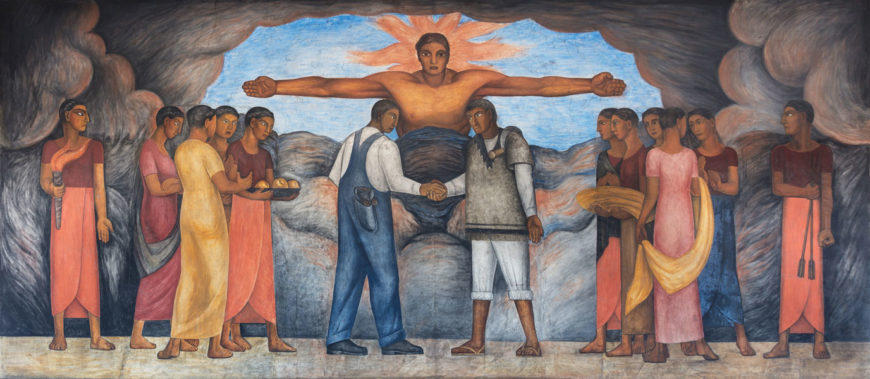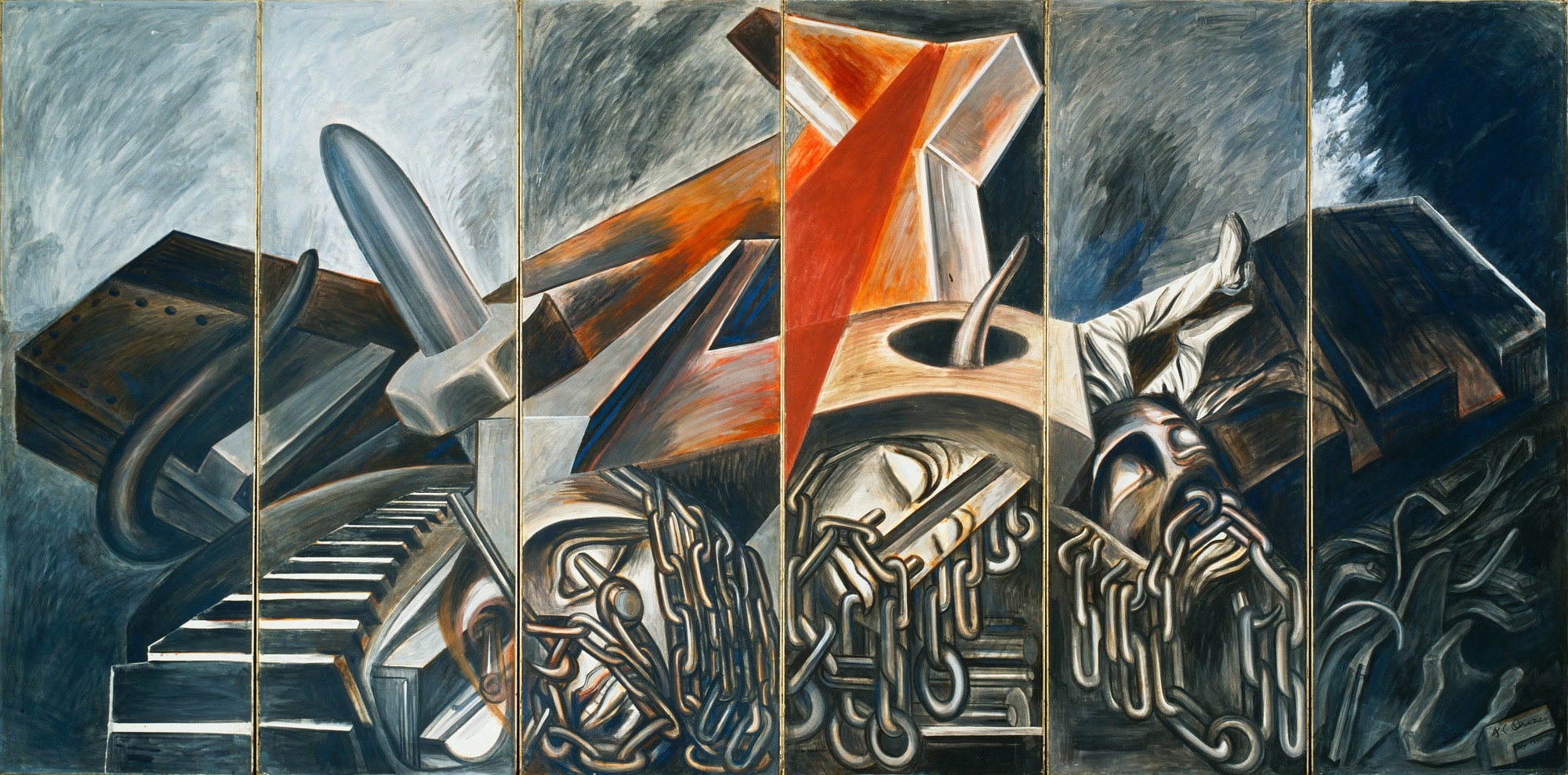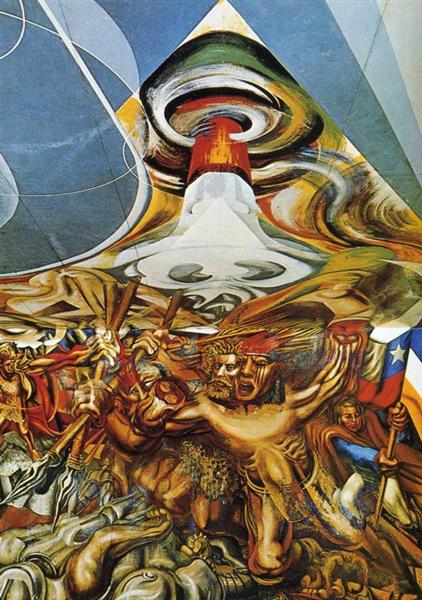Art in Mexico: Mexican Muralism
Art featured in the Mexican Mural Movement from the 1920s-1950s
Background Information
From 1910 to 1920, there was a civil war, also termed a Revolution, between the citizens of Mexico and the powerful dictator, Porfirio Diaz. Those who resided in Mexico fought for agrarian reform meaning those who labor should have control of the land. The conclusion of the Revolution ushered in a new age for Mexican society and the government started to commission artists to create works that would provide education about rich and valuable Mexican history. Because of this, the Mexican Mural Movement came to fruition and became a prominent artistic style that defined Mexican identity from the 1920s to the 1950s.
This particular movement was led by what many called Los Tres Grandes or "the three great ones". Siqueriros, Diego Rivera, and José Clemente Orozco were the influential men in the Mural Movement after the Revolution of the early twentieth century. These artists would craft beautiful art murals on public buildings or in visible spaces featuring artistic techniques including mosaic, fresco, sculpture-painting, and encaustic. As for the subject matter, the murals were an iconography that often highlighted non-European heroes from Mexico's historical past, present, and future. Throughout this post, the beautiful works from Los Tres Grandes will be presented to pay tribute to the awe-inspiring art produced with Mexican influence from 1920-1950.
Virtual Exhibit
Fraternity by Diego Rivera in 1928

The first piece to explore is titled Fraternity which was created by Diego Rivera in 1928 and is located on the third floor of the Court of Labor in Mexico City, Mexico. Rivera created this particular piece to depict the unity of struggle between the industrial worker and the campesino, a peasant farmer. The unity can be seen through the two figures shaking hands in the middle of the mural. The Greek god Apollo is situated in the background of the image who is the deity of both medicine and beauty to emphasize notable social development through both science and art. This mural strives to highlight the togetherness that was essential in the midst of the Revolution and the new unity across societal classes.
The utilization of both light and darkness is something to note in this piece. The dark-toned clouds in the background can be seen to represent the deep struggle in early twentieth-century Mexico which contrasts with the shining hope being illuminated in the center blue sky. Detailed emotions on the figure's faces, including uncertainty and concern, convey the idea that this type of unity had previously never occurred in the country, but was greatly necessary for success in the Revolution. The colors and types of clothing whether vibrant or simplistic shed light on ideas like societal status. I enjoyed learning about the historical aspect behind this piece and how it relates to the reconstruction of Mexico's society. The symbol of unity and fraternity is quite moving and the mural's cohesiveness is greatly appealing.
Dive Bomber and Tank by José Orozco in 1940

Dive Bomber and Tank, a beautifully crafted fresco painting, created by José Orozco in 1940 is located in The Museum of Modern Art in New York where he also crafted it. It consists of six panels that tell of the effects of modern warfare on humanity. His piece was an addition to the exhibition titled "Twenty Centuries of Mexican Art" where approximately 5,000 distinct works of folk, colonial, modern, and ancient Mexican art were displayed for onlookers to gain important insight into Mexico's history and culture. Orozco portrays the triumph of war over humanity by adding only small traces of the human figure. The legs seen in the fifth panel and the three masks buried across panels two through five are the only presence of humanity.
I think one of the most intriguing features of this piece is that the panels can be arranged in any order which results in various abstract compositions. The monochromatic palette and selection of colors also play a role in the abstract nature of this piece and give it a more somber feeling. Expressionist brushstrokes are prevalent across all panels and add both strong texture and a sense of intensity. I was drawn to this piece by Orozco because the imagery was immensely powerful. Dive Bomber and Tank is considered to be a more abstract modern mural that took part in the Mexican Mural Movement by showcasing an awe-inspiring Mexican modernist art form.
Death to the Invader by Siqueriros in 1941-42

The last piece to examine is an allegorical mural created by Siqueriros, the last artist part of Los Tres Grandes, in 1941-42. Death to the Invader is a fresco mural that is displayed in a small library of Escuela Mexico in Chillan, Chile. This piece spans two walls and a ceiling to make the figures seem larger than life. On the south wall, Siqueriros depicts Chilean indigenous people fighting for independence from European Conquistadores while the north wall represents a similar story but features indigenous people from Mexico. In the very center, Galvarino, a 16th-century Mapuche warrior, is incorporated as well as other historical leaders of both resistance and independence. Siqueriros wanted to create a large-scale mural that not only represented Mexican culture but also inspired a sense of activism in those that viewed his work.
There are an abundant amount of elements found in this particular work. An element of drama is greatly apparent through the detailed emotions on the figure's faces and the way their bodies are positioned. Siqueriros also beautifully crafted a piece that can be viewed from multiple perspectives. Each perspective tells a different story and brings certain aspects to life. The viewer can feel an elevated sense of energy through the tense and triumphant raising of Galvarino's arms and battle cry. Finally, I love the incorporation of a wide range of colors that complement each other in a seemingly perfect way. Siqueriros' work is greatly impressive to me because he was able to intertwine so many historically significant elements together in a visually appealing manner. Don't rush to examine this piece, there are so many integral elements to uncover!
Conclusion
The Mexican Mural Movement strove to educate individuals from all walks of life about the valuable history of Mexico through stunning artistic murals. Siqueriros, Diego Rivera, and José Clemente Orozco are three very influential Mexican artists that made this Movement quite notable. Rivera was able to highlight the social reconstruction of Mexico post-Revolution through Fraternity. Orozco touched on the effects of modern warfare on humanity and contributed his modern mural art to an exhibition that promotes the deep discovery and examination of Mexican art forms. Finally, Siqueriros crafted a large-scale allegorical mural depicting both indigenous Chilean and Mexican people striving for independence and resisting control. All three of these mural paintings encapsulate different aspects of Mexican art forms and accomplish their own respective goals.
Sources
Bravo, Dr. Doris Maria-Reina. “Mexican Muralism: Los Tres Grandes-David Alfaro Siqueiros, Diego Rivera, and José Clemente Orozco.” Smarthistory, https://smarthistory.org/mexican-muralism-los-tres-grandes-david-alfaro-siqueiros-diego-rivera-and-jose-clemente-orozco/.
Flattley, Megan. “Diego Rivera, Stairwell and Third Floor ‘Court of Labor’ at the Sep.” Smarthistory, https://smarthistory.org/diego-rivera-stairwell-third-floor-court-labor-murals-secretaria-educacion-publica/.
Jiménez, Dr. Maya. “José Clemente Orozco, Dive Bomber and Tank.” Smarthistory, https://smarthistory.org/orozco-dive-bomber-and-tank/.
“Siqueiros Paintings, Bio, Ideas.” The Art Story, https://www.theartstory.org/artist/siqueiros-david-alfaro/.
“Twenty Centuries of Mexican Art: Moma.” The Museum of Modern Art, https://www.moma.org/calendar/exhibitions/2985.
Great blog post Libbey! Mexican art is very intriguing and does an amazing job of expressing emotions. On of my favorite aspects about the works presented are the value and color contrast seen in "Dive Bomber and Tank." The value makes this appear extremely realistic but still keeping an abstract touch. A common theme I see in the paintings are sorrow, the chains around the heads of the people in "Dive Bomber and Tank" and "Death to the Invader." Another theme I see within the art pieces is balance, seen in all images every single piece has a great sense of symmetrical balance which is very interesting. The texture done in these artworks are done very nicely, the brushstrokes are very even giving the texture a very full look. Great blog Libbey.
ReplyDeleteHello! Good job on providing the background information on Mexico Muralism. The idea on art reconstructing society makes me feel happy that it was their passion. The painting titled Fraternity by Diego Rivera stands out to me because of the meaning and value behind the artwork. The man with opened arms symbolizes welcoming to the people or in this case society. Diego Rivera was Frida Kahlo’s husband a famous Mexican painter. Thank you for sharing and you did an amazing job!
ReplyDeleteLove how detailed you went through for this. I really enjoyed Death to the Invader by Siqueriros in 1941-42. It seems very abstract and allows for the painting to be seen in different perspectives.
ReplyDeleteHi Libbey, great blog post this week! I really enjoyed the background information that you provided for the time period, as well as for each artwork. Dive Bomber and Tank by José Orozco is my favorite of the three because I love the color story and the overall image is quite interesting. Murals are absolutely beautiful and I love the symbolism that is incorporated in many. Thank you for sharing!
ReplyDeleteHi Libbey, I really liked how much detail you put into this bog post. I really like Dive Bomber and Tank by José Orozco because of how unique it looks. Thank you for sharing!
ReplyDelete